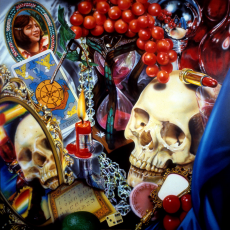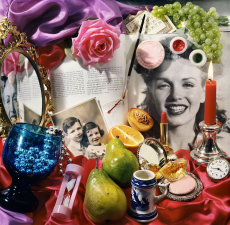
Email: nadege.preston@hotmail.com
Total Article : 82
About Me:Hi I’m Nadege and I study French at the University of Leeds, and I have just completed my third year abroad in Montpellier studying literature and enjoying the sunshine! I love art; painting and being creative, as well as photography and baking. Travelling is my favourite hobby at the moment; experiencing the French language and culture. I hope you enjoy reading some of my articles!

Audrey Flack, a truly inspirational painter, sculptor and pioneer of Photorealism has greatly has influenced me with her works, specifically those based around this style of art. Photorealism stems from the Pop Art movement which emerged in the 1950s, and it is for this reason that Flack uses vibrant and saturated colours with iconic symbols to create eye-catching photographs in which she transforms into paintings.
The Photorealistic style Flack uses struck me instantly as I was fascinated by the way she captures photographs whilst shooting in deeply saturated colour, and creates almost identical reciprocates of these as paintings in a completely realistic style. Flack therefore knows how to construct striking photographs and as an artist, Flack is associated with creating saturated, bold, vibrant and colourful images that portray mesmerizing compositions. At a first glance, the composition of Flack’s photographs may appear random, but when overviewing many of Flack’s works, it is noticeable that Flack uses levels and builds the picture with clusters of specific objects linked to certain themes. These themes are used by Flack in order to tell a ‘story’ which is very effective as it creates a deeper meaning to the image than what first meets the eye. A key example of this can be noted in Flack’s works on Vanitas which is an old form of symbolic painting. The Vanitas in relation to Flack are a trio of paintings (Wheel of Fortune, Marilyn, World War II) which she created that have still-life themes and deal with morality. ‘Vanitas’ can be defined as the visual expression of the vanities in life. Consequently, life, death and pleasure can be identified in Flack’s trio of photographs/paintings.

The ‘story’ that is created by Flack is demonstrated in the ‘Wheel of Fortune’ (IMAGE 1) with the die portraying how life is a gamble and that fate decides the future whereas ‘Marilyn’ (IMAGE 2) demonstrates with the sex symbol that beauty is not everything, for example, with the half-cut sensual fruits suggesting that they will rot and ultimately ‘die’.
Consequently, I admire Flack because there is a lot of thought behind the image she constructs in relation to the images’ aesthetics and purpose. What is most intriguing is the fact that Flack clearly shows each object though they are tightly clustered and the objects are purposely of different sizes to create levels and add complexity to the photograph. To add to this, Flack also incorporates the background of her photographs into the foreground and the mid-ground and it is often created out of cloth/fabric which adds texture, tones and shadows and is quite an unusual trait in her photographs.
At the height of Photorealism in the 1970s, Flack was criticized as her works were considered as ‘too feminine’ in comparison to her contemporaries such as Chuck Close who famously created the ‘Big Self Portrait’. Flack on the other hand moves away from the ‘cool’ tones and masculine aspects in her works and focuses instead on more feminine objects and colours; ‘My colours are bright, my subject matter passionate and humanist, the opposite of cool and restrained, the opposite of the other Photo Realists’ (Audrey Flack, 2009).
Though this brought about criticism to her photographs, it also distinguishes Flack from other Photorealist artists and makes her photographs more outstanding. For example, in the photograph ‘Invocation’, the ‘feminine’ elements such as the ribbon adds a sensual element, with the light of the candle reflected and the flowers portraying passion, life and colour but also symbolising death. Flack definitely was not restrained in her compositions, despite criticism, which is why I admire her.
IMAGE 1 URL
http://www.meiselgallery.com/lkmg/imagesDB/Flack_Wheel-of-Fortune_1977-78_acrylic-and-oil-on-canvas.jpg (Wheel of Fortune, 1977-78, Audrey Flack)
IMAGE 2 URL
http://41.media.tumblr.com/tumblr_maz3zvFOtM1qcdbeso1_1280.jpg (Marilyn, 1977, Audrey Flack)

0 Comment:
Be the first one to comment on this article.